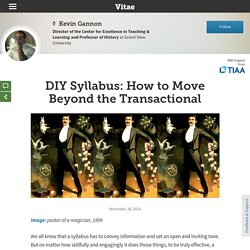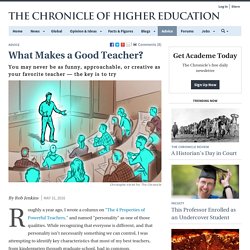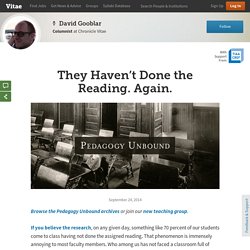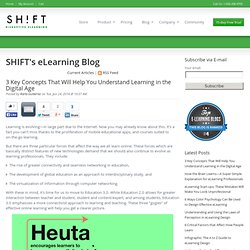

DIY Syllabus: How to Move Beyond the Transactional. Image: poster of a magician, 1899 We all know that a syllabus has to convey information and set an open and inviting tone.

But no matter how skillfully and engagingly it does those things, to be truly effective, a syllabus has to move beyond the basics and embody the actual substance of the course. In the two previous installments of DIY Syllabus, I considered what a syllabus is (and isn’t) and the types of things that should go into (and stay out of) a course syllabus. In this latest installment, I’d like to consider how we can use our syllabi to do more than merely convey information or set the tone for the course.
To be sure, those are essential functions of a syllabus, and it’s important to do them well. But stopping there keeps the syllabus firmly within the realm of the transactional, when what we’re really after in our teaching is the transformational. The key element was the sense of ownership imparted to the students. Moreover, the “promise” of this model extends to us as well. What Makes a Good Teacher? Roughly a year ago, I wrote a column on "The 4 Properties of Powerful Teachers," and named "personality" as one of those qualities.

While recognizing that everyone is different, and that personality isn’t necessarily something we can control, I was attempting to identify key characteristics that most of my best teachers, from kindergarten through graduate school, had in common. When I say "best teachers," I’m not just talking about the ones I liked best.
I mean the teachers who had the greatest influence on me — the ones whose names I still remember to this day, even though in some cases it’s been more than 40 years since I sat in their classrooms. They are people I’ve tried to emulate in my own teaching. What made them good teachers? We may never be as funny, approachable, or creative as our favorite teachers. They are good-natured. They are professional without being aloof. They have a good sense of humor. They Haven’t Done the Reading. Again. Browse the Pedagogy Unbound archives or join our new teaching group.

If you believe the research, on any given day, something like 70 percent of our students come to class having not done the assigned reading. That phenomenon is immensely annoying to most faculty members. Who among us has not faced a classroom full of blank stares, with seemingly no one prepared to answer the well-thought-out question we've asked about the reading? How can we solve that problem? How can we ensure that students are meeting what should be a very basic responsibility? Well, we can give quizzes. So what else can you do if you don't want to introduce regular reading quizzes? The first thing to do: Make sure that your required reading is actually required. So go through your syllabus, and make sure that all of your reading assignments are there for a reason, and that it’s actually necessary to complete the readings to meet the course objectives.
Heutagogy - Heutagogy: designing for self-directed learners. John Helmer and Steve Barden look at the pros and cons of a theory that promises to help learning and development teams with designing programmes for self-directed learners.

Here’s another unlovely word to blame the Ancient Greeks for: Heutagogy. Pedagogy has long had a place in the e-learning bluffer’s guide: when someone is banging on about the latest much-hyped phenomenon – be it m-learning, informal learning or MOOCs – a safe counter has always been to put the head on one side and say, ‘yes, but what’s the pedagogy?’ Advanced students of lifemanship will have learned to sidestep any counter-counters to this play by moving swiftly on to Andragogy, which is pedagogy for grown-ups – but Heutagogy trumps even this. Putting one-upmanship aside for a moment though, what is Heutagogy – and do you really need to bother with it?
We think you do. Why Heutagogy matters now This paradigm shift leaves something of a theory gap. Why heutagogy might have problems getting traction. 3 Key Concepts That Will Help You Understand Learning in the Digital Age. 3 Key Concepts That Will Help You Understand Learning in the Digital Age Learning is evolving—in large part due to the Internet.

Now you may already know about this. It's a fact you can't miss thanks to the proliferation of mobile educational apps, and courses suited to on-the-go learning. But there are three particular forces that affect the way we all learn online. These forces which are basically distinct features of new technologies demand that we should also continue to evolve as learning professionals. The rise of greater connectivity and seamless networking in education,The development of global education as an approach to interdisciplinary study, andThe virtualization of information through computer networking.
With these in mind, it's time for us to move to Education 3.0. 1) Heutagogy Heutagogy, a concept developed in 2000 by Stewart Hase, refers to the study of self-determined learning. Embracing heutagogy is especially important in today's information-rich world. 3) Cybergogy.